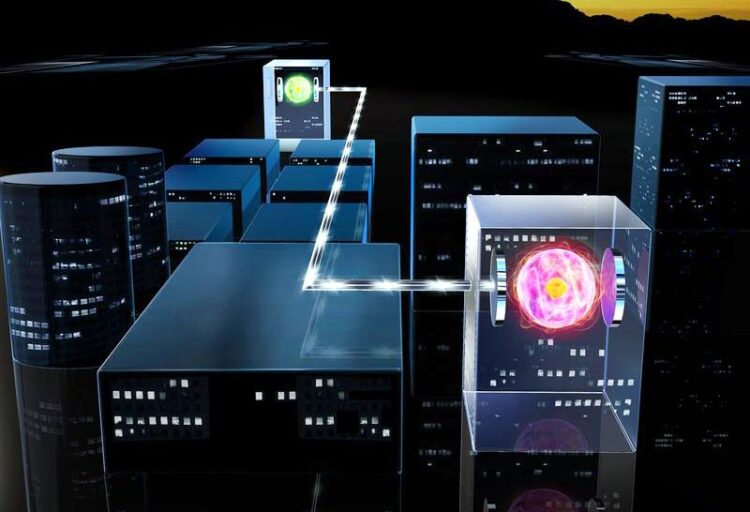Entangled atoms across the Innsbruck quantum network

The nodes of this network were housed in two labs at the Campus Technik to the west of Innsbruck, Austria.
Credit: Harald Ritsch / Universität Innsbruck
Trapped ions have previously only been entangled in one and the same laboratory. Now, teams led by Tracy Northup and Ben Lanyon from the University of Innsbruck have entangled two ions over a distance of 230 meters. The nodes of this network were housed in two labs at the Campus Technik to the west of Innsbruck, Austria. The experiment shows that trapped ions are a promising platform for future quantum networks that span cities and eventually continents.
Trapped ions are one of the leading systems to build quantum computers and other quantum technologies. To link multiple such quantum systems, interfaces are needed through which the quantum information can be transmitted. In recent years, researchers led by Tracy Northup and Ben Lanyon at the University of Innsbruck’s Department of Experimental Physics have developed a method for doing this by trapping atoms in optical cavities such that quantum information can be efficiently transferred to light particles. The light particles can then be sent through optical fibers to connect atoms at different locations. Now, their teams, together with theorists led by Nicolas Sangouard of the Université Paris-Saclay, have for the first time entangled two trapped ions more than a few meters apart.
Platform for building quantum networks
The two quantum systems were set up in in two laboratories, one in the building that houses the Department of Experimental Physics and one in the building that houses the Institute of Quantum Optics and Quantum Information of the Austrian Academy of Sciences. “Until now, trapped ions were only entangled with each other over a few meters in the same laboratory. Those results were also achieved using shared control systems and photons (light particles) with wavelengths that aren’t suitable for travelling over much longer distances,” Ben Lanyon explains.
After years of research and development, the Innsbruck physicists have now managed to entangle two ions across campus. “To do this, we sent individual photons entangled with the ions over a 500-meter fiber optic cable and superimposed them on each other, swapping the entanglement to the two remote ions,” says Tracy Northup, describing the experiment. “Our results show that trapped ions are a promising platform for realizing future distributed networks of quantum computers, quantum sensors and atomic clocks.”
Ben Lanyon’s and Tracy Northup’s teams are part of the Quantum Internet Alliance, an international project under the European Union’s Quantum Flagship. The latest results have been published in Physical Review Letters. The research was financially supported by the Austrian Science Fund FWF and the European Union, among others.
Wissenschaftliche Ansprechpartner:
Tracy Northup
Department of Experimental Physics
University of Innsbruck
p +43 512 507 52463
e Tracy.Northup@uibk.ac.at
w https://www.uibk.ac.at/exphys/quantum-interfaces/
Ben Lanyon
Department of Experimental Physics
University of Innsbruck
p +43 512 507 52900
e ben.lanyon@uibk.ac.at
w http://www.quantumoptics.at/
Originalpublikation:
Entanglement of trapped-ion qubits separated by 230 meters. V. Krutyanskiy, M. Galli, V. Krcmarsky, S. Baier, D. A. Fioretto, Y. Pu, A. Mazloom, P. Sekatski, M. Canteri, M. Teller, J. Schupp, J. Bate, M. Meraner, N. Sangouard, B. P. Lanyon, T. E. Northup. Phys. Rev. Lett. 130, 050803 doi: https://doi.org/10.1103/PhysRevLett.130.050803
Weitere Informationen:
https://physics.aps.org/articles/v16/s20 – Physics Synopsis: Trapped Ions Go the Distance
Media Contact
All latest news from the category: Information Technology
Here you can find a summary of innovations in the fields of information and data processing and up-to-date developments on IT equipment and hardware.
This area covers topics such as IT services, IT architectures, IT management and telecommunications.
Newest articles

NASA: Mystery of life’s handedness deepens
The mystery of why life uses molecules with specific orientations has deepened with a NASA-funded discovery that RNA — a key molecule thought to have potentially held the instructions for…

What are the effects of historic lithium mining on water quality?
Study reveals low levels of common contaminants but high levels of other elements in waters associated with an abandoned lithium mine. Lithium ore and mining waste from a historic lithium…

Quantum-inspired design boosts efficiency of heat-to-electricity conversion
Rice engineers take unconventional route to improving thermophotovoltaic systems. Researchers at Rice University have found a new way to improve a key element of thermophotovoltaic (TPV) systems, which convert heat…



